AUDI A4 AVANT 2008 Owners Manual
Manufacturer: AUDI, Model Year: 2008, Model line: A4 AVANT, Model: AUDI A4 AVANT 2008Pages: 368, PDF Size: 46.19 MB
Page 191 of 368
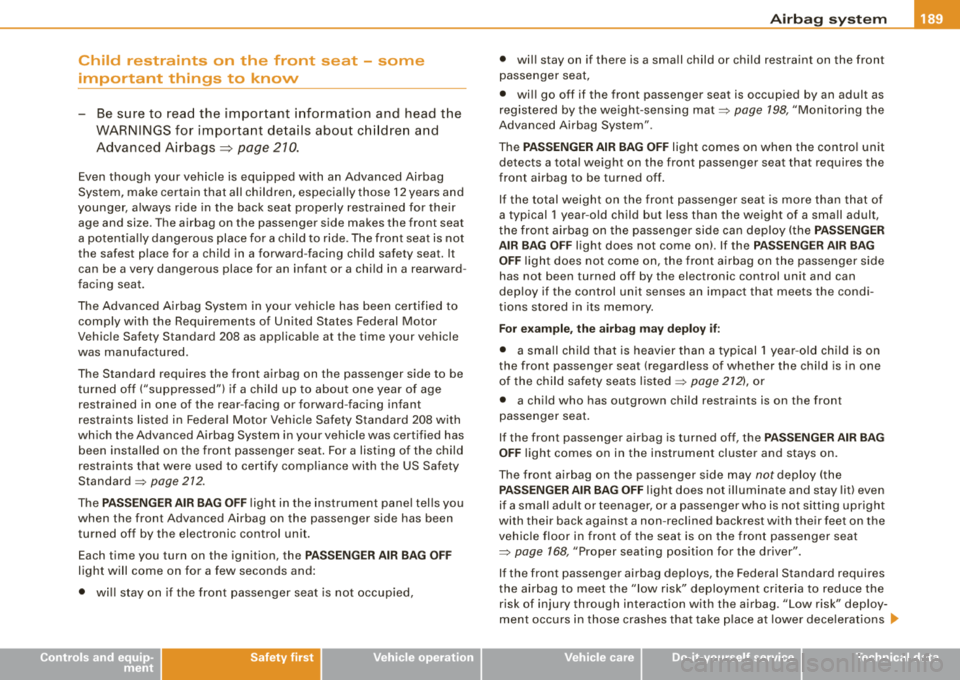
__________________________________________________ A_ i_ r _b _a-' g=- s_ y=-- s_t _e _m ______ lfflll
Child restraints on the front seat - some
important things to know
- Be sure to read the important information and head the
WARNINGS for important details about children and
Advanced
Airbags=> page 210.
Even though your vehicle is equipped with an Advanced Airbag
System, make certain that all children, especially those 12 years and
younger, always ride in the back seat properly restrained for their
age and size . The airbag on the passenger side makes the front seat
a potentially dangerous place for a child to ride. The front seat is not
the safest place for a child in a forward -facing child safety seat. It
can be a very dangerous place for an infant or a child in a rearward
facing seat.
The Advanced Airbag System in your vehicle has been certified to comply with the Requirements of United States Federal Motor
Vehicle Safety Standard 208 as applicable at the time your vehicle
was manufactured.
The Standard requires the front airbag on the passenger side to be
turned off ("suppressed") if a child up to about one year of age
restrained in one of the rear-facing or forward-facing infant
restraints listed in Federal Motor Vehicle Safety Standard 208 with
which the Advanced Airbag System in your vehicle was certified has been installed on the front passenger seat. For a listing of the child
restraints that were used to certify compliance with the US Safety
Standard ::::, page 212.
The PASSENGER AIR BAG OFF light in the instrument panel tells you
when the front Advanced Airbag on the passenger side has been
turned off by the electronic control unit.
Each time you turn on the ignition, the
PASSENGER AIR BAG OFF
light will come on for a few seconds and:
• will stay on if the front passenger seat is not occupied,
Controls and equip
ment Safety first
Vehicle operation
• will stay on if there is a small child or child restraint on the front
passenger seat,
• will go off if the front passenger seat is occupied by an adult as
registered by the weight-sensing
mat ::::, page 198, "Monitoring the
Advanced Airbag System" .
The
PASSENGER AIR BAG OFF light comes on when the control unit
detects a total weight on the front passenger seat that requires the
front airbag to be turned off.
If the total weight on the front passenger seat is more than that of
a typical 1 year-old child but less than the weight of a small adult,
the front airbag on the passenger side can deploy (the
PASSENGER
AIR BAG OFF
light does not come on). If the PASSENGER AIR BAG
OFF
light does not come on, the front airbag on the passenger side
has not been turned off by the electronic control unit and can
deploy if the control unit senses an impact that meets the condi
tions stored in its memory.
For example, the airbag may deploy if:
• a small child that is heavier than a typical 1 year-old child is on
the front passenger seat (regardless of whether the child is in one
of the child safety seats
listed ::::, page 212), or
• a child who has outgrown child restraints is on the front
passenger seat.
If the front passenger airbag is turned off, the
PASSENGER AIR BAG
OFF
light comes on in the instrument cluster and stays on.
The front airbag on the passenger side may
not deploy (the
PASSENGER AIR BAG OFF light does not illuminate and stay lit) even
if a small adult or teenager, or a passenger who is not sitting upright
with their back against a non-reclined backrest with their feet on the
vehicle floor in front of the seat is on the front passenger seat
=> page 168, "Proper seating position for the driver".
If the front passenger airbag deploys, the Federal Standard requires
the airbag to meet the "low risk" deployment criteria to reduce the risk of injury through interaction with the airbag . "Low risk" deploy
ment occurs in those crashes that take place at lower decelerations _,,.
Vehicle care Do-it-yourself service Technical data
Page 192 of 368
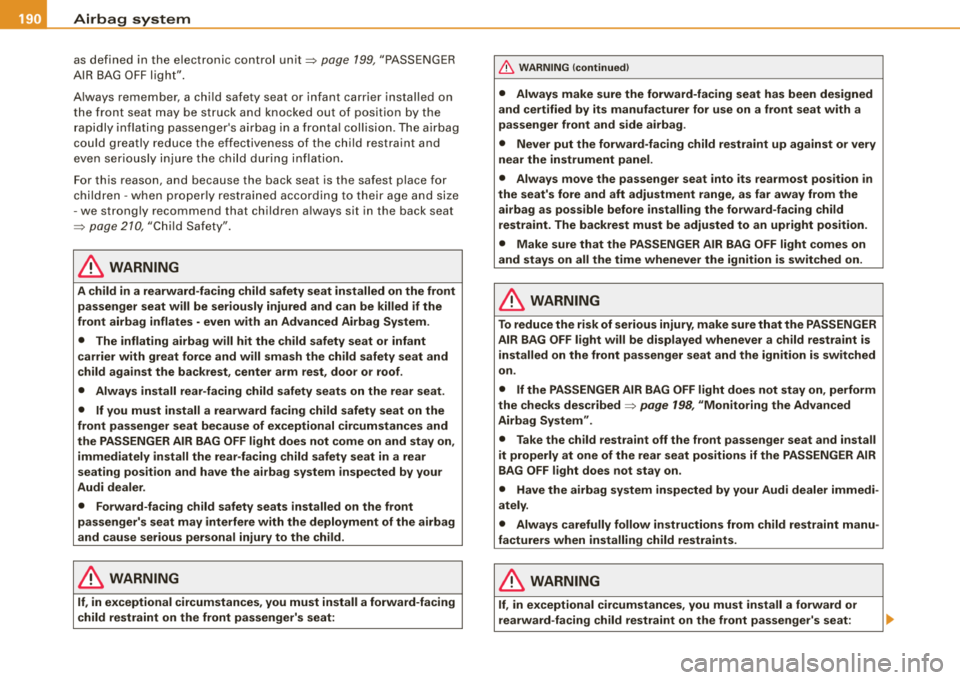
___ A_ ir_b _ a_ g=- s--=- y_s _t _e _m _________________________________________________ _
as defi ne d i n th e el ectronic contro l unit=> page 19 9, " PA SSE NGER
AI R B AG OFF lig ht ".
A lways remember, a c hild safety s eat or infant carrier instal led on
the front seat may be struck and knocked out of po sition by the
r a pi dly i nfla ting passe nger's ai rbag in a fron tal c olli sion . The a irbag
co uld greatly red uce the effectiveness of the child restraint and
e ven se riou sly inju re the child d urin g infla tion .
F or th is reason, and because the bac k seat is the safest plac e for
chi ldr en
-whe n prop erly r estrain ed accord in g to t he ir age an d size
-we stro ngly recomme nd that ch il d ren a lwa ys sit in the bac k se at
=> p age 210, "Child S afety".
& WARNING
A child in a rearward -facing child safety seat installed on the front
passenger seat will be seriously injured and can be killed if the
front airbag inflates
-even with an Advanced Airbag System .
• The inflating airbag will hit the child safety seat or infant
carrier with great force and will smash the child safety seat and
child against the ba ckrest , center arm rest , door or roof .
• Always install rear-facing child safety seats on the rear seat .
• If you must install a rearward facing child safety seat on the
front passenger seat because of exceptional circumstances and
the PASSENGER AIR BAG OFF light does not come on and stay on ,
immediately install the rear-facing child safety seat in a rear
seating position and have the airbag system inspected by your
Audi dealer .
• Forward-facing child safety seats installed on the front
passenger's seat may interfere with the deployment of the airbag
and cause serious personal injury to the child .
& WARNING
If, in exceptional circumstances , you must install a forward-facing
child restraint on the front passenger's seat:
& WARNING (continued)
• Always make sure the forward-facing seat has been designed
and certified by its manufacturer for use on a front seat with a
passenger front and side airbag .
• Never put the forward-facing child restraint up against or very
near the instrument panel.
• Always move the passenger seat into its rearmost position in
the seat's fore and aft adjustment range, as far away from the
airbag as possible before installing the forward-facing child
restraint. The backrest must be adjusted to an upright position.
• Make sure that the PASSENGER AIR BAG OFF light comes on
and stays on all the time whenever the ignition is switched on.
& WARNING
To reduce the risk of serious injury , make sure that the PASSENGER
AIR BAG OFF light will be displayed whenever a child restraint is
installed on the front passenger seat and the ignition is switched
on.
• If the PASSENGER AIR BAG OFF light does not stay on, perform
the checks
described => page 198, "Monitoring the Advanced
Airbag System" .
• Take the child restraint off the front passenger seat and install
it properly at one of the rear seat positions if the PASSENGER AIR
BAG OFF light does not stay on.
• Have the airbag system inspected by your Audi dealer immedi
ately .
• Always carefully follow instructions from child restraint manu
facturers when installing child restraints .
& WARNING
If, in exceptional circumstances, you must install a forward or
rearward -facing child restraint on the front passenger's seat :
Page 193 of 368
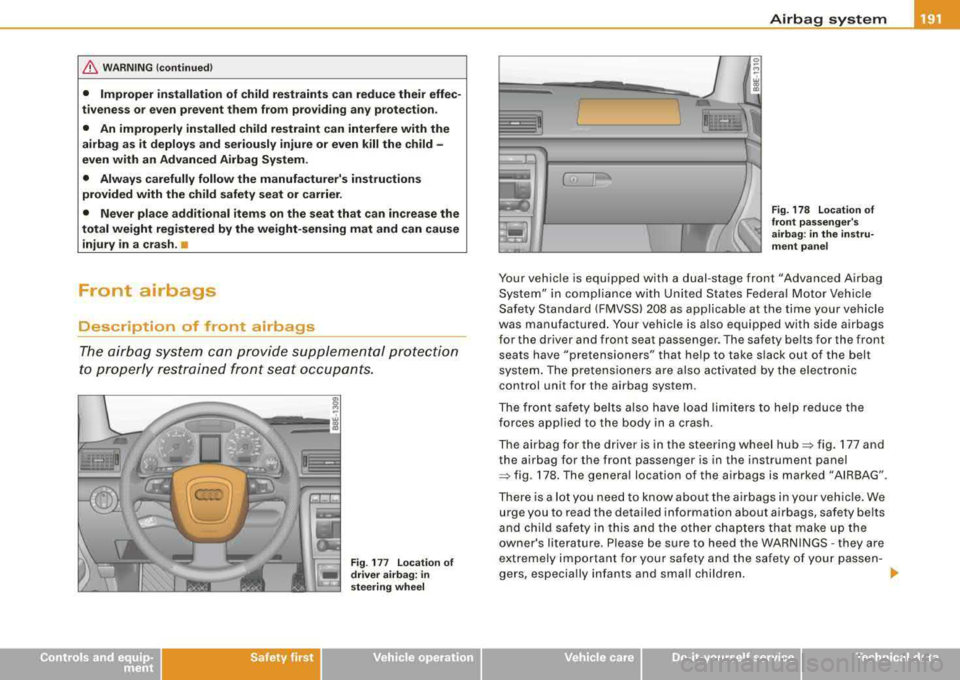
/b, WARNING (continued )
• Improper installation of child restraints can reduce their effec
tiveness o r even prevent them from providing any protection .
• An improperly installed child restraint can interfere with the
airbag a s it deploys and ser iously injure or even kill the child -
even with an Advanced Airbag System .
• Alway s carefully follow the manufacturer's instructions
provided with the child safety seat or carrier .
• Never place additional items on the seat that can in crease the
total weight registered by the weight -sensing mat and can cause
injury in a crash. •
Front airbags
Description of front airbags
The air bag sys tem can pr ovi de s upp lem ental pro tecti on
t o p rop erly restr ained front se a t oc cupants.
Safety first
Fig . 177 Location of
driver airb ag : in
s teering wheel
( I p
Airbag system
Fig. 178 Location of
front pa ssen ger 's
airbag : in the instru
ment p anel
Your vehic le is equipped with a dual -stage front "Advanced Airbag
System" in compl ia nce wi th Uni ted Sta tes Federa l Motor Ve hic le
Safety Standard (FMVSSl 208 as applicable at the time your vehicle
w as manufactured . Your vehicle is a lso equipped with side airbags
fo r the driver and front seat passenger . The safety belts for the front
seats have "pretensioners" that he lp to take s lack out of the belt
syste m. The p re te nsioners a re a lso activated by t he elec tronic
control unit for the airbag system.
The front safety belts a ls o have loa d lim iters to help reduce the
forces app lied to the body in a crash .
The airbag fo r the driver is in the steering wheel
hub => fig. 177 and
the airbag for t he front passenger is in the instrument pane l
=> fig. 178. The genera l location of the airbags is marked "AIRBAG" .
Th ere is a l ot you nee d t o know abou t the airbags in y our ve hicle. We
urge you to read the detailed information about airbags, safety be lts
and c hild safe ty in this and the ot her c hapt ers that mak e up the
owner 's lit erature. P lease be sure to heed the WARN INGS -they are
extremely importa nt for you r safety a nd the safety of you r passe n-
g ers, especially infants and small children.
..,
irechnical data
Page 194 of 368
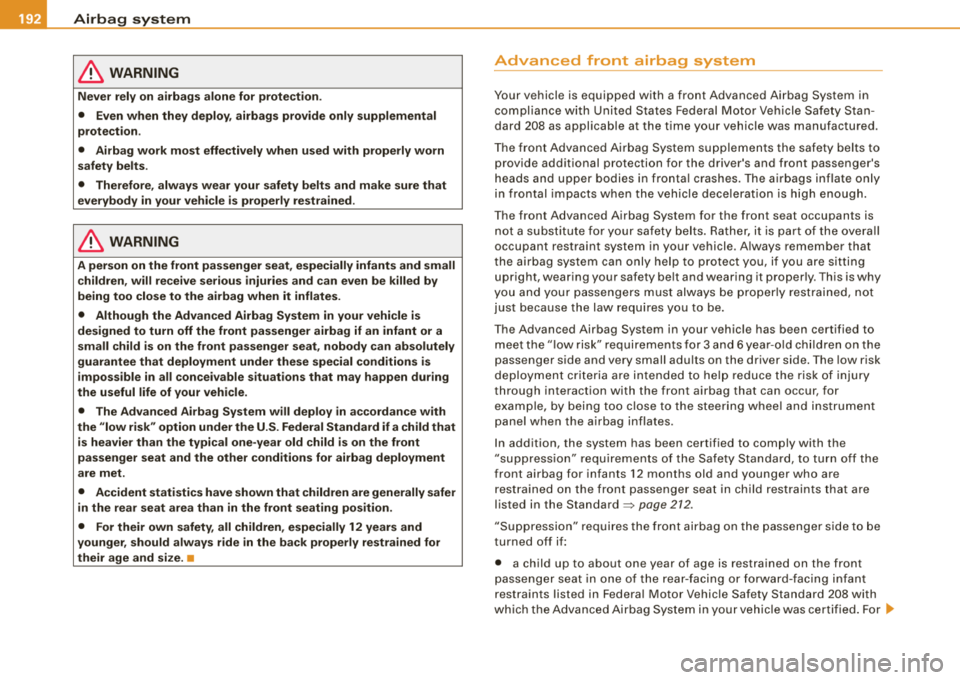
-Airbag system
----:=-..:....--------------------------------------------
& WARNING
Never rely on airbags alone for protection.
• Even when they deploy, airbags provide only supplemental
protection .
• Airbag work most effectively when used with properly worn
safety belts.
• Therefore, always wear your safety belts and make sure that
everybody in your vehicle is properly restrained.
& WARNING
A person on the front passenger seat, especially infants and small children, will receive serious injuries and can even be killed by
being too close to the airbag when it inflates.
• Although the Advanced Airbag System in your vehicle is
designed to turn off the front passenger airbag if an infant or a
small child is on the front passenger seat, nobody can absolutely
guarantee that deployment under these special conditions is
impossible in all conceivable situations that may happen during
the useful life of your vehicle.
• The Advanced Airbag System will deploy in accordance with
the
"low risk" option under the U.S. Federal Standard if a child that
is heavier than the typical one-year old child is on the front
passenger seat and the other conditions for airbag deployment
are met.
• Accident statistics have shown that children are generally safer
in the rear seat area than in the front seating position.
• For their own safety, all children, especially 12 years and
younger, should always ride in the back properly restrained for
their age and size.
•
Advanced front airbag system
Your vehicle is equipped with a front Advanced Airbag System in compliance with United States Federal Motor Vehicle Safety Stan
dard 208 as applicable at the time your vehicle was manufactured .
The front Advanced Airbag System supplements the safety belts to
provide additional protection for the driver's and front passenger's
heads and upper bodies in frontal crashes. The airbags inflate only
in frontal impacts when the vehicle deceleration is high enough.
The front Advanced Airbag System for the front seat occupants is
not a substitute for your safety belts. Rather, it is part of the overall
occupant restraint system in your vehicle . Always remember that
the airbag system can only help to protect you, if you are sitting
upright, wearing your safety belt and wearing it properly. This is why
you and your passengers must always be properly restrained, not
just because the law requires you to be.
The Advanced Airbag System in your vehicle has been certified to
meet the "low risk" requirements for 3 and 6 year-old children on the
passenger side and very small adults on the driver side. The low risk
deployment criteria are intended to help reduce the risk of injury
through interaction with the front airbag that can occur, for example, by being too close to the steering wheel and instrument
panel when the airbag inflates .
In addition, the system has been certified to comply with the
"suppression" requirements of the Safety Standard, to turn off the
front airbag for infants 12 months old and younger who are
restrained on the front passenger seat in child restraints that are
listed in the
Standard~ page 272 .
"Suppression" requires the front airbag on the passenger side to be
turned off if:
• a child up to about one year of age is restrained on the front
passenger seat in one of the rear-facing or forward-facing infant
restraints listed in Federal Motor Vehicle Safety Standard 208 with
which the Advanced Airbag System in your vehicle was certified. For
~
Page 195 of 368
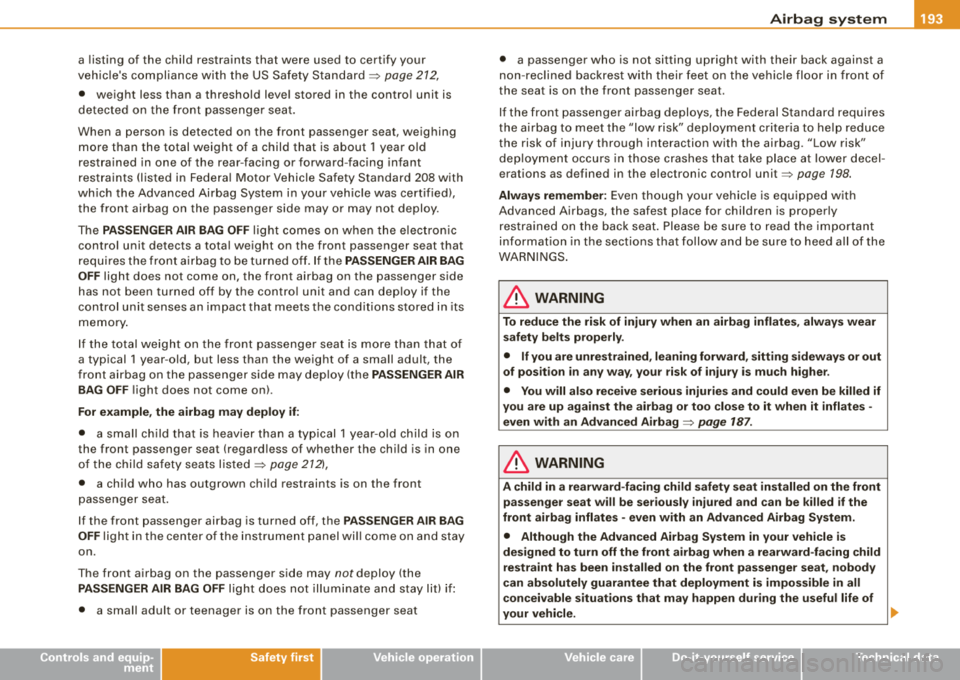
__________________________________________________ A_ i_ r _b _a-' g=- s_ y=-- s_t _e _m ______ lllll
a listing of the child restraints that were used to certify your
veh ic le 's compliance wi th the US Safety
Standa rd => page 212,
• weight less than a threshold leve l stored in the contro l unit is
de tected on the fro nt passenger sea t.
When a person is detected on the front passenger seat, weighing mo re t han the total weight of a c hild that is about 1 yea r old
restra ined in one of the rear -facing or forward -facing infant
restraints (listed in Federa l Motor Vehicle Safety Standard 208 with
wh ic h the Adva nced Airba g System in your ve hicle was certified),
the front airbag on the passenger side may or may not deploy.
The
PASSENGER AIR BAG OFF l ight c omes on whe n the e le ctr oni c
control unit detects a total weight on the front passenger seat that
r equi res t he front a irbag to be tu rned o ff . I f the
PASSENGER AIR BAG
OFF
light does not come on, the front airbag on the passenger s ide
has no t been tu rned off by t he con tro l uni t and can dep loy if the
co ntrol unit se nses an i mpact that meets t he conditio ns store d in its
memo ry .
I f t he total we ig ht on the front passe nge r seat is more than t hat of
a typical
1 year -old, but less than the we ight of a small adult, the
fr ont airbag on the passe nger s ide may dep loy (the
PASSENGER AIR
BAG OFF
l ight does not come on) .
For example, the airbag may deploy if:
• a small c hild t hat is heavier than a typ ical 1 yea r-old child is on
the front passenger seat (regard less of whether the child is in one
o f t he child sa fe ty sea ts
liste d=> page 212),
• a child who has outgrown chi ld restraints is on the front
passenge r seat .
I f the front passenger airbag is turned off, the
PASSENGER AIR BAG
OFF
light in the ce nter of the i nstrument pa nel wi ll come on and stay
on.
T he front airbag on the passenger side may
not deploy (the
PASSENGER AIR BAG OFF ligh t does not illum inate a nd stay lit) if:
• a small adult or teenager is on the front passenger seat
Controls and equip
ment Safety first
Vehicle operation
• a passenger who is not s itting upright with their back against a
no n-rec li n ed bac kres t wi th th eir fee t on th e ve hicle flo or in fro nt of
the seat is on the front passenger seat.
If the front passenger airbag deploys, the Federal Standard requi res
the airbag to meet t he "low r isk" deploy ment cr iteria to help reduce
the risk of injury th roug h interaction with the airbag. "Low risk"
dep loyment occu rs in those cras hes t hat take place a t lo wer decel
erations as defined in the electronic control
unit=> page 198.
Always remember: Even though yo ur vehicle is equ ipped w ith
Advanced Airbags, the safest p lace for children is properly
res tra ined on the back sea t. Please be s ure to rea d th e impo rtant
i nformat io n i n t he sections tha t follow a nd be sure to heed a ll of the
WA RNIN GS .
& WARNING
To reduce the risk of injury when an airbag inflates, always wear
safety belts properly .
• If you are unrestrained , leaning forward , sitting sideways or out
of position in any way , your risk of injury is mu ch higher .
• You will al so receive serious injuries and could even be killed if
you are up again st the airbag or too close to it when it inflates -
even with an Advanced
Airbag => page 187.
& WARNING
A child in a rearward-facing child safety seat installed on the front
passenger seat will be ser iously injured and can be killed if the
front airbag inflate s -even with an Advanced Airbag System.
• Although the Advan ced Airbag System in your vehicle is
designed to turn off the front airbag when a rearward -facing child
restraint has been installed on the front passenger seat , nobody
can ab solutely guarantee that deployment is impo ssible in all
c onceivable situat ions that may happen during the useful life of
your vehicle. _,,.
Vehicle care Do-it-yourself service Technical data
Page 196 of 368

___ A_ ir_b _ a_ g=- s--=- y_s _t _e _m _________________________________________________ _
&, WARNIN G (continu ed )
• The inflating airbag will hit the child s afety seat or infant
car rier with gre at for ce and will sma sh the child safe ty se at and
c hild agai nst the ba ckre st, center arm re st, door , or roof .
• Alwa ys in sta ll re arw ard -f aci ng child re str aint s in the b ack se at .
• If you mu st in stall a rearw ard facing child safety seat on the
front p assenger se at be cause of e xce pti ona l ci rc um stan ce s a nd
the PASSENGER AIR BAG OFF light doe s not come on and stay on ,
immedi atel y insta ll the re ar-f a cing child s afet y s ea t in a re ar
se ating position and h av e the airb ag sy stem inspe cted by your
Audi dealer .
& WARNING
If, in e xception al c ir cum sta nces, you mu st in sta ll a forward -f ac in g
c hild re straint on the front p assenger 's seat:
• Alway s mak e sure the forward-f acing seat ha s been designed
and certified by it s manufacturer for u se on a front seat with a
p asseng er front and side airb ag .
• Never put the forw ard -fa cing child re straint up again st or very
near the instrument panel.
• Alway s move the p assenger seat into it s re armost position in
the se at's fore and aft adju stment range , as far a way from the
a irbag a s pos sible , before installing the forward -f a cing child
rest raint . The ba ckrest must be ad justed to an upright po sitio n.
• Make sure that the PASSENGER AIR BAG OFF light come s on
a nd stay s on all th e time whenever the ignit ion i s swi tched on .
•
Advanced Airbag System components
The front passenger seat in your vehicle has a lot of very impo rtant
parts of the Advanced A irbag System in it . These parts include the
we ight -sensing mat , sensors, wiring, brackets , and more. The func -tion of the system in the front passenger seat is checked by the e
lec
tronic contro l unit w hen t he ignit ion is on . The co ntrol uni t monitors
the Advanced Airbag System and turns the airbag indicator light on
whe n a malfunction i n the system components is detected. T he
function of the airbag ind icator light is described in greater detai l
below. Because the front passenger seat contains important parts
o f the Advanced Airbag System, you must take care to prevent it
from being damaged . Damage to the seat may prevent the
Advanced Airbag for the front passenger seat from do ing its job in
a crash .
The front Adva nc ed Airbag S ystem consi sts of th e
following :
• Crash sensors in the front of the ve hicle that measure veh ic le
acce leration/deceleration to provide information to the Advanced
A irbag System about t he severity of t he crash .
• An electronic control unit, with integrated crash sensors for front
and side impacts. The control unit "dec ides" whethe r to fire the
front airbags based on the information received from the crash sensors . The control unit also "dec ides" whether the safety be lt
pretensioners should be activated.
• A dual -stage Advanced Airbag with gas generator for the driver
inside the steering wheel hub.
• A dual-stage Advanced A irbag and gas generator inside the
instrument pane l for the front passenger .
• A we ight -sensing mat under the upholstery padding of the front
passenger seat cushion that measures the tota l weight on the seat .
T he information registered is sent continuously to the electronic
control un it to regu late dep loyment of the front Advanced Airbag on
the passenger side .
• An airbag monitor ing system and indicator light in the instru
ment
cluster=> page 198 .
• The PASSENGER AIR BAG OFF light comes on and stays on in t he
center of the instrument panel
=> page 199, fig . 180 and te lls you
when the fron t Advanced Airbag on the passenger side has been
turned off.
~
Page 197 of 368

Airbag system 111111
-------------------------------------------- -=-:~--___.
• A sensor below the safety belt latch for the front seat passenger
t o m easure the tens io n on t he sa fety be lt. T he tension on the safe ty
belt and the weight registered by the weight -sensing mat help the
contr ol unit "decide" whe the r the front ai rbag for the fron t
passenger seat should be turned off or
not=> page 189, "Child
r est ra ints on the front seat - some important th ings to know".
• A sensor in the safety belt latch for the driver and for the front
seat passenge r that senses whether t hat safety bel t is la tched or no t
and transmits this information to the e lectronic control unit.
& WARNING
Damage to the front pas senger seat can pre vent the front airbag
from working properly.
• Improper repair or disassembly of the front passenger and
driver seat will prevent the Advanced Airbag System from func
tioning properly .
• Repairs to the front passenger seat must be performed by qual
ified and properly trained workshop personnel .
• Never remove the front pa ssenger or driver seat from the
vehi cle .
• Ne ver remo ve the upholstery from the front passenger seat .
• Never disassemble or remove parts from the seat or disconnect
wires from it .
• Never carry sharp objects in your pockets or place them on the
seat . If the weight -sen sing mat in the passenger seat i s pun ctured
it cannot work properly.
• Never carry things on your lap or carry objects on the
passenger seat . Such items can increase the weight registered by
the weight -sensing mat and send the wrong informat ion to the
airbag control unit .
• Never store items under the front passenger seat . Parts of the
Advanced Airbag System under the passenger seat could be
d amaged , preventing them and the airbag system from working
properly.
Controls and equip ment Safety first
Vehicle operation
& WARNING (continued )
• Never place seat covers or replacement upholstery that have
not been specifically appro ved by Audi on the front seat s.
• Seat covers can prevent the Advanced Airbag System from
recognizing child restraint s or occupants on the front passenger
seat and prevent the side airbag in the seat backrest from
deploying properly.
• Never use cushions, pillows , blankets or similar items on the
front passenger seat. The additional padd ing will prevent the
weight-sensing mat in the seat from accurately registering the
child restraint or person on the seat and prevent the Ad vanced
Airbag System from functioning properly .
• If you mu st use a child re straint on the front pas senger seat
and the child restraint manufacturer's instru ctions require the use
of a towel , foam cu shion or something el se to properly position
the child restraint , make certain that the PASSENGER AIR BAG OFF
light comes on and stays on whenever the child restraint i s
installed on the front passenger seat.
• If the PASSENG ER AIR BAG OFF light does not come on and stay
on , immed iately install child re straint in a re ar seat ing position
and have the airbag sy stem inspected by your Audi dealer . •
How the Advanced Airbag System
components work together
The front Advanced Airbag System and the side airbags supplement
the prote ction off ered by the fro nt three -p oi nt safe ty belts with
pretensioners and load limiters and the adjustable head restra ints
to help reduce the risk of injury in a wide range of accident and
crash situations. Be sure to read the important informat ion about
safety and heed the WARNI NGS in this chapter.
Dep loyment of the Adva nced Ai rbag Sys tem a nd th e activation of
the safety belt pretensioners depends on the dece leration
measu red by the crash senso rs and registered by the electro nic _.,
Vehicle care Do-it-yourself service Technical data
Page 198 of 368
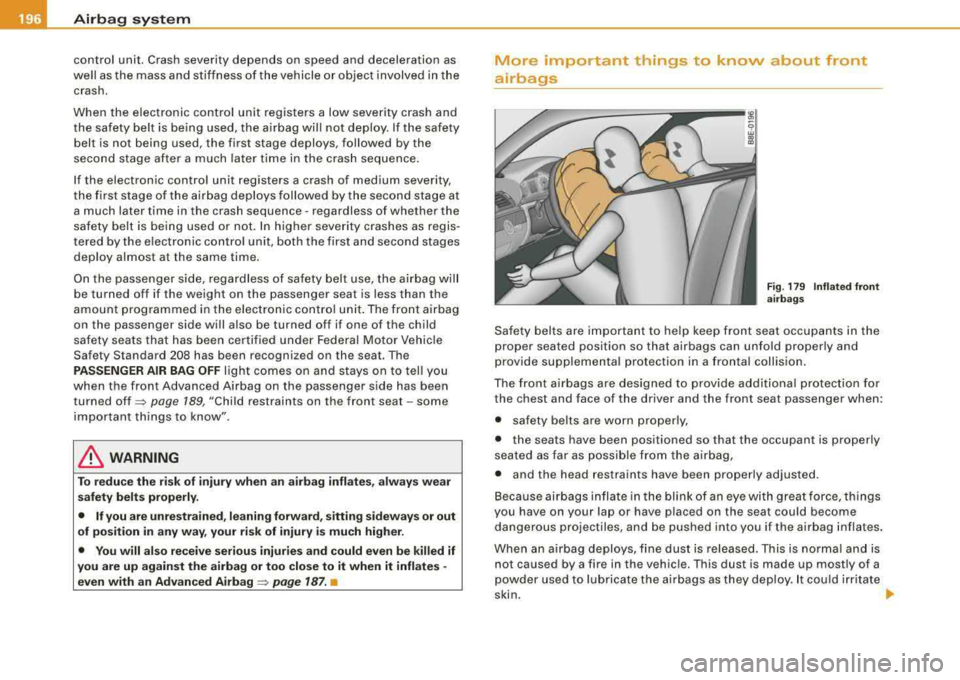
___ A_ ir_b _ a_ g
=-- s
-=- y_s _t _e _m _________________________________________________ _
control unit . Crash severity depends on speed and deceleration as
well as the mass and stiffness of the vehicle or object involved in the crash .
When the electronic control unit registers a low severity crash and
the safety belt is being used, the airbag will not deploy. If the safety belt is not being used, the first stage deploys, followed by the
second stage after a much later time in the crash sequence .
If the electronic contro l unit registers a crash of medium severity,
t he fi rst stage of the airbag deploys followed by the second stage at
a much later time in the crash sequence -regardless of whether the
safety be lt is be ing used or not. In higher severity crashes as regis
tered by the e lectronic contro l unit , both the first and second stages
deploy almost at the same time .
On the passenger side, regardless of sa fety belt use, the airbag w ill
be turned off if the weight on the passenger seat is less than th e
amount programmed in the electronic contro l un it . The front airbag
on the passenger side wi ll also be turned off if one of the child
safety seats that has been certified under Federa l Motor Vehic le
Safety Standard 208 has been recognized on the seat. The
PASSENGER AIR BAG OFF ligh t comes on and stays on to tel l you
when the front Advanced Airbag on the passenger side has been
turned
of f=> page 189 , "Child restraints on the front seat -some
important things to know".
& WARNING
To reduce the ri sk of inju ry when an airbag infl ates , always wear
s afety belts properly .
• If you a re unrestr ained , leaning forward , sitting sideway s or out
of po sition in any way , your risk of injury i s much high er.
• You will al so rece ive se riou s injur ie s a nd could e ven be killed if
y ou are up again st the airbag or too close to it when it inflates -
e ven with an Advanced
A irbag => page 187. •
More important things to know about front
airbags
Fig . 179 Inflate d fr ont
airbag s
Safety belts are important to he lp keep front seat occupants in the
proper seated position so that airbags can unfold properly and
provide supplemental protection in a fronta l collision.
The front airbags are designed to provide additiona l protect ion for
the chest and face of the driver and the front seat passenger when:
• safety be lts are worn properly,
• the seats have been pos itioned so that the occupant is properly
seated as far as p ossi ble from the airbag,
• and the head restra ints have been properly adjusted.
Because airbags inflate in the blink of an eye with great force , thi ngs
you have on your lap or have placed on the seat cou ld become
dangerous projectiles, and be pushed into you if the airbag inf lates .
When an airbag deploys, fine dust is released. This is norma l and is
not caused by a fire in the vehic le. This dust is made up most ly of a
powder used to lubricate t he airbags as they deploy . It could irritate
skin.
~
Page 199 of 368
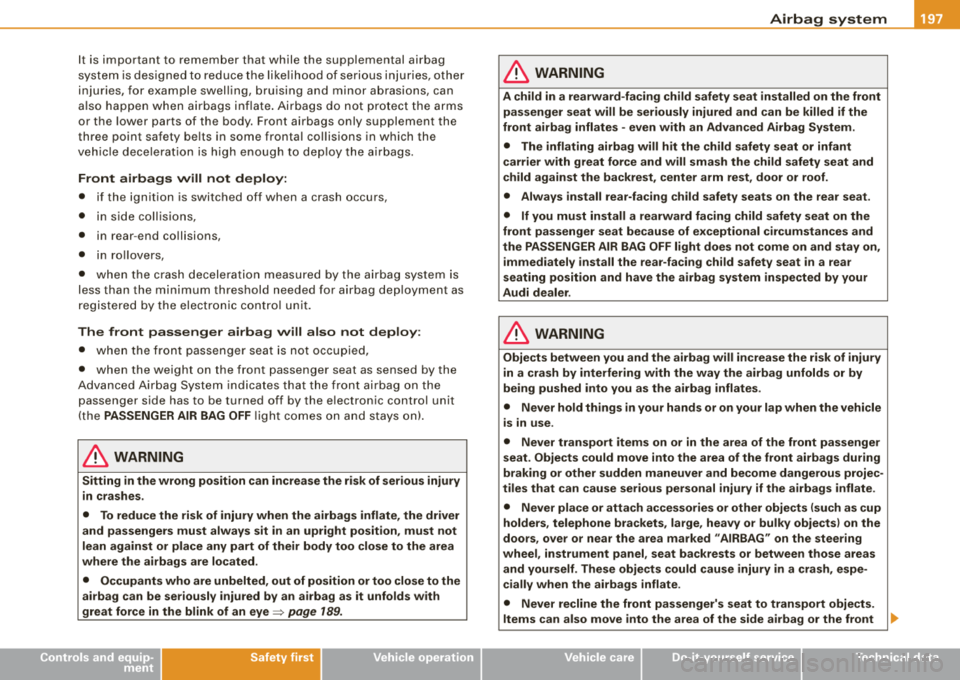
Airbag system 111111
-----------------------------=--=-------
It is important to remember that while the supplemental airbag
system is designed to reduce the likelihood of serious injuries, other
injuries, for example swelling, bruising and minor abrasions, can
also happen when airbags inflate. Airbags do not protect the arms
or the lower parts of the body. Front airbags only supplement the
three point safety belts in some frontal collisions in which the
vehicle deceleration is high enough to deploy the airbags.
Front airbags
will not deploy:
• if the ignition is switched off when a crash occurs,
• in side collisions,
• in rear -end collisions,
• in rollovers ,
• when the crash deceleration measured by the airbag system is
less than the minimum threshold needed for airbag deployment as
registered by the electronic control unit.
The front passenger airbag
will also not deploy:
• when the front passenger seat is not occupied,
• when the weight on the front passenger seat as sensed by the
Advanced Airbag System indicates that the front airbag on the
passenger side has to be turned off by the electronic control unit
(the PASSENGER AIR BAG OFF light comes on and stays onl.
& WARNING
Sitting in the wrong position can increase the risk of serious injury
in crashes.
• To reduce the risk of injury when the airbags inflate, the driver
and passengers must always sit in an upright position, must not
lean against or place any part of their body too close to the area
where the airbags are located.
• Occupants who are unbelted, out of position or too close to the
airbag can be seriously injured by an airbag as it unfolds with
great force in the blink of an
eye :::::, page 189.
Controls and equip ment Safety first
Vehicle operation
& WARNING
A child in a rearward-facing child safety seat installed on the front
passenger seat will be seriously injured and can be killed if the
front airbag inflates
-even with an Advanced Airbag System.
• The inflating airbag will hit the child safety seat or infant
carrier with great force and will smash the child safety seat and
child against the backrest, center arm rest, door or roof.
• Always install rear-facing child safety seats on the rear seat.
• If you must install a rearward facing child safety seat on the
front passenger seat because of exceptional circumstances and
the PASSENGER AIR BAG OFF light does not come on and stay on, immediately install the rear-facing child safety seat in a rear
seating position and have the airbag system inspected by your
Audi dealer .
& WARNING
Objects between you and the airbag will increase the risk of injury
in a crash by interfering with the way the airbag unfolds or by
being pushed into you as the airbag inflates .
• Never hold things in your hands or on your lap when the vehicle
is in use.
• Never transport items on or in the area of the front passenger
seat. Objects could move into the area of the front airbags during
braking or other sudden maneuver and become dangerous projec
tiles that can cause serious personal injury if the airbags inflate.
• Never place or attach accessories or other objects (such as cup
holders, telephone brackets, large, heavy or bulky objects) on the
doors, over or near the area marked "AIRBAG" on the steering
wheel, instrument panel, seat backrests or between those areas
and yourself. These objects could cause injury in a crash, espe
cially when the airbags inflate.
• Never recline the front passenger's seat to transport objects.
Items can also move into the area of the side airbag or the front _,,
Vehicle care Do-it-yourself service Technical data
Page 200 of 368
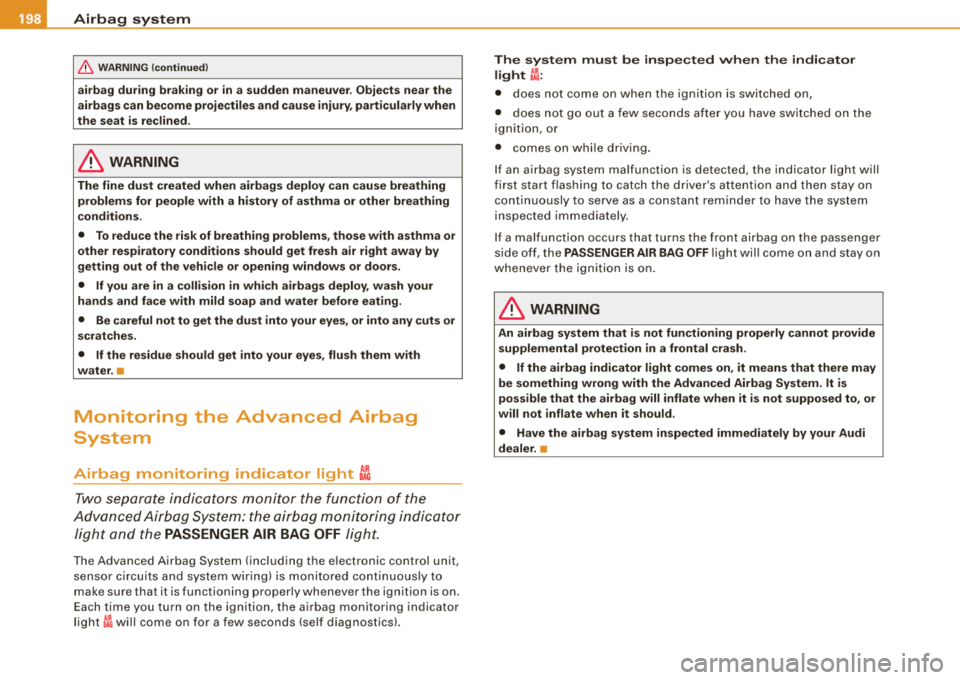
___ A_ ir_b _ a_ g=- s--=- y_s _t _e _m _________________________________________________ _
&, WARNING (continued )
airbag during braking or in a sudden maneuver . Objects near the
airbags can become projectiles and cause injury , particularly when
the seat is re clined .
& WARNING
The fine dust created when airbags deploy can cause breathing
problems for people with a history of asthma or other breathing
c ondit ions .
• To reduce the risk of breathing problems , those with asthma or
other respiratory conditions should get fresh air right away by
getting out of the vehicle or opening windows or doors .
• If you are in a collision in which airbags deploy, wash your
hands and face with mild soap and water before eating .
• Be careful not to get the dust into your eyes, or into any cuts or
scratches.
• If the residue should get into your eyes, flush them with
water. •
Monitoring the Advanced Airbag
System
Airbag monitoring indicator light t~
Two separate indicators monitor the func tion of the
Advanced A irba g System: th e airbag mon itoring ind ica tor
li g ht and the
PASSENGER AIR BAG OFF light.
T he Advanced Airbag System (inc luding the e lectronic control unit,
s en sor c ircuit s and s yste m wiri ng ) is moni tored con tin uou sly to
make sure that it is f unctioning properly whenever the ignition is o n.
E ac h time you t urn on the ignit ion , th e airb ag monito ring indic ator
light ~ will come on for a f ew s econds (s elf dia gnostics).
The system must be inspected when the indicator
light m:
• does not come on when the i gnition is switched on,
• d oes not go out a few sec onds after y ou h ave sw itch ed on th e
ignit ion, or
• comes on w hile d riv ing.
I f an airbag system malfunction is detected, the indicator li ght will
fir st sta rt fl ashing to ca tch the drive r's att ention a nd then s tay o n
cont inuously to serve as a cons tant rem inder to hav e the s yst em
in spec ted i mm ediatel y.
If a m alfu nctio n occ urs th at t urns the fron t airb ag on the pass eng er
s ide off, the PASSENGER AIR BAG OFF light will come on and stay on
w hen eve r th e ig niti on is on.
& WARNING
An airbag system that is not functioning properly cannot provide
supplemental protection in a frontal crash .
• If the airbag indicator light comes on , it means that there may
be something wrong with the Advanced Airbag System. It is
possible that the airbag will inflate when it is not supposed to , or
will not inflate when it should .
• Have the airbag system inspected immediately by your Audi
dealer .•